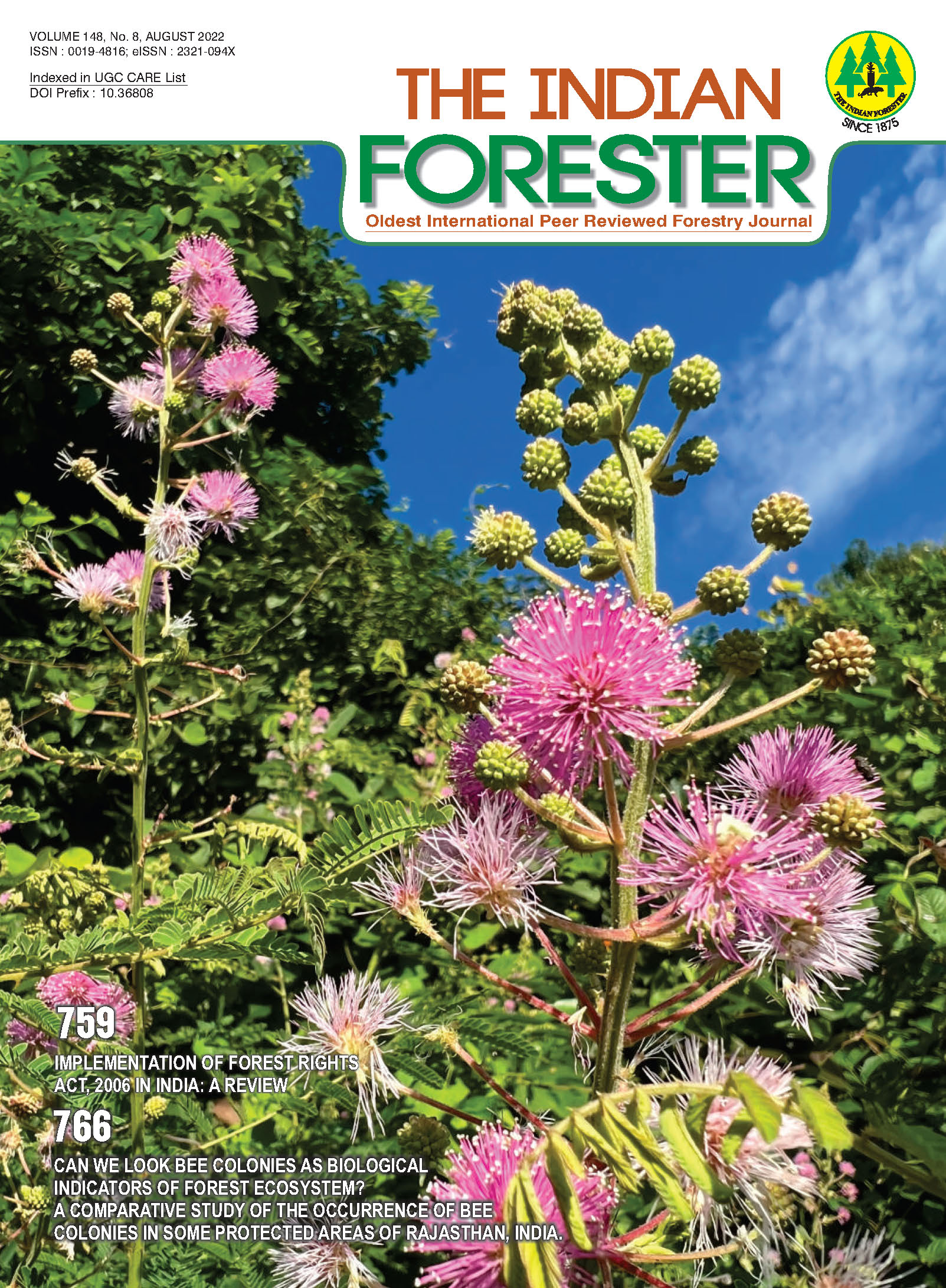Biodiversity of Medicinal Plants in Unakoti District, Tripura
DOI:
https://doi.org/10.36808/if/2022/v148i8/153743Keywords:
Ayurveda, Medicinal Plant, Tribe, Unakoti, TripuraAbstract
Unakoti District is located in the Northern part of the Tripura state and literal meaning is one less a koti (Crore) in Bengali, hosts an ancient Shaivite place of worship with huge rock reliefs celebrating Shiva. The study area is with unique floral biodiversity and well protected by local population and forest department. Seasonal Medico Ethno Botanical Survey conducted in forests of Kailashahar and Kumarghat of Unakoti district of Tripura to enlist medicinal plants. Collected specimens were digitally photographed, accessioned and incorporated in the herbarium. A total of 140 plants specimens belong to 117 genera belong to 54 families have been collected and separated 77 Ayurvedic medicinal plants from the enlisted plants. The study is a natural repository of Ayurvedic medicinal plants and their use in day today life by tribes and non tribes who are dwelling in the forest. This area can be developed as traditional treatment tourist point to benefit the local people and state.References
Anupam G. and Daina C. (2015). Traditional usage of EthnoMedicinal plants among the Chakma community of Tripura, India. Global Journal of Pharmacology, 9(4): 377-384.
Anupam G., Sukla C. and Kakali N. (2018b). Traditional knowledge and Biodiversity of Ethno medicinal plants used by the ethnic people of Tripura, North East India: Proceedings: 2nd International online Conference of Biological Sciences, 22 July 2018. (Dr.) Poulami Majumder, Maulana Abul Kalam Azad University of Technology, India.
Anupam G., Sukla C., Kakali N. and Debashish S. (2018a). Underutilized plants of Tripura used as a spices and Ethnomedicinal purpose by Manipuri Community. International Journal of Agriculture, Environment and Biotechnology, 459-467.
Banani D., Anupam D.T. and Choudhury M. D. (2014). A few traditional medicinal plants used as antifertility agents by ethnic people of Tripura, India. International journal of pharmacy and pharmaceutical Sciences, 6(3): 47-53.
Bennet S.S.R. (1987). Name Changes in Flowering Plants of India and Adjacent Regions, Triseas Publications. 772
Das S. and Choudhary M.D. (2010) Plants used against Gastro-Intestinal Disorders and anti Haemorrhagic by three tribes of North Tripura District, Tripura, India: A report. Ethnobotanical leaflets, 14: 467-78.
Deb D.B. (1981) The flora of the Tripura state Vol (I). Today and Tomorrows Printer and publishers, 509 pp.
Deb D.B. (1983). The flora of Tripura state Volume (II). Today and Tomorrows Printer and publishers, 601 pp.
Himangshu B.D., Koushik M., Dutta B.K. and Denasis R. (2009). Ethnobotanical uses of some plants by Tripuri and Reang tribes of Tripura. Natural product Radiance, 8(2): 172- 180.
Jain S.K. and Rao R.R. (1977). A Hand Book of Field and Herbarium Methods. Today and Tomorrow's Printers and Publishers, New Delhi, 157 pp.
Koushik M. and Datta B.K. (2007). A study on ethnomedicinal usage of plants among the folklore herbalist and Tripuri medical practioners: Part-II. Natural Product Radiance, 6(1): 66-73.
Koushik M., Reema S., Datta B.K. and Bhakta T. (2006). Medicinal plants prescribed by different tribal and non-tribal medicine me of Tripura state. Indian Journal of Traditional Knowledge, 5(4): 559-562.
Lawrence G.H.M. (1969). Taxonomy of Vascular Plants. Second Indian Reprint, Oxford and IBH Publishing Co, Calcutta, 823 pp.
Maria D., Nazir A.P., Munesh K. and Rainer W.B. (2017). Traditional knowledge of medicinal plants in tribes of Tripura in North East India. Traditional, Complementary and Alternative Medicine, 14(4): 156-168.
Pawan K.K. and Poulami S. (2018). Traditional healing practices of tribal healers. Van Sangyan, 5(3): 11-20.
Ramananda G.T., Sushmita N., Anupam D.T. and Manabendra D.C. (2015). Anti diabetic plants used among the ethnic communities of Unakoti district of Tripura, India. Journal of Ethnopharmacology, 160: 219-226.
Sharma S.K. (1998). Rashtriya Ayurveda Vidyapeeth (National Academy of Ayurveda), Medicinal plants used in Ayurveda. 238 pp.
Shil S. and Choudhury M.D. (2009). Ethnomedicinal importance of Pteridophytes used by Reang tribe of Tripura, North East India. Ethnobotanical leaflets, 13: 634-43.
Singh K.P., Singh D.K., Choudhury P.R., Dilip K.K., Bora P.J. and Bujarbarua N.P. (2002). Flora of Mizoram Volume-I. Botanical survey of India (Ministry of Environment and forest). 845 pp.
Singh K.P., Sinha G.P., Shukla B.K., Chowdhury G. and Banik D. (2012). Flora of Mizoram Volume (II), Botanical survey of India (Ministry of Environment and forest). 649 pp.
Somnath K. and Dutta B.K. (2015). A glimpse of the traditional uses of plants by Koloi subtribe of Tripura. Journal of Botanical Society of Bengal, 69(2): 147-152.
Sudesh P.S. and Poornima S. (2017). A study on some plants by Tripuri and Reang Tribes Tripura using Ethnobotanical in India. International Journal of Advance Research and Innovative Ideas in Education, 4(4): 2395-4396.
Downloads
Downloads
Published
How to Cite
Issue
Section
License
Unless otherwise stated, copyright or similar rights in all materials presented on the site, including graphical images, are owned by Indian Forester.





